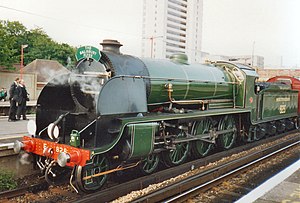LSWR Class S15

Preserved No. 828
|
|||||||||||||||||||||||||||||||
|
|||||||||||||||||||||||||||||||
|
|||||||||||||||||||||||||||||||
|
|||||||||||||||||||||||||||||||
|
|||||||||||||||||||||||||||||||
| Type and origin | |
|---|---|
| Power type | Steam |
| Designer | Robert Urie, modified by Richard Maunsell |
| Builder | LSWR/SR Eastleigh Works |
| Build date | 1920–1936 |
| Total produced | 45 |
| Specifications | |
|---|---|
| Configuration | 4-6-0 |
| UIC class | 2′C h2 |
| Gauge | 4 ft 8 1⁄2 in (1,435 mm) standard gauge |
| Leading dia. | 3 ft 7 in (1.092 m) |
| Driver dia. | 5 ft 7 in (1.702 m) |
| Length | 65 ft 6.75 in (19.98 m) |
| Total weight | Urie: 135 long tons 21 cwt (138.2 t; 152.4 short tons) Maunsell: 135 long tons 13 cwt (137.8 t; 151.9 short tons) |
| Fuel type | Coal |
| Fuel capacity | 5 long tons (5.08 t; 5.60 short tons) |
| Water cap | 5,000 imp gal (23,000 L; 6,000 US gal) |
| Boiler pressure | Urie locomotives: 180 psi (1.24 MPa); Saturated Boiler: 175 psi (1.21 MPa); Maunsell locomotives: 200 psi (1.38 MPa) |
| Cylinders | Two, outside |
| Cylinder size |
Urie: 21 in × 28 in (533 mm × 711 mm); Maunsell: 20.5 in × 28 in (521 mm × 711 mm) |
| Valve gear | Walschaerts |
| Performance figures | |
|---|---|
| Tractive effort |
Urie: 28,200 lbf (125.4 kN); Maunsell: 29,860 lbf (132.8 kN) |
| Career | |
|---|---|
| Operators | |
| Class | S15 |
| Power class |
|
| Numbers |
|
| Withdrawn | 1962–1966 |
| Disposition | Seven preserved, remainder scrapped |
The LSWR S15 class was a British 2-cylinder 4-6-0 freight steam locomotive designed by Robert W. Urie, based on his H15 class and N15 class locomotives. The class had a complex build history, spanning several years of construction from 1920 to 1936. The first examples were constructed for the London and South Western Railway (LSWR), where they hauled freight trains to the south coast ports and further west to Exeter, as well as occasional passenger work in conjunction with their larger-wheeled N15 class counterparts.
Following the Grouping of railway companies in 1923, the LSWR became part of the Southern Railway, and the Chief Mechanical Engineer (CME) of the newly formed company, Richard Maunsell, increased the S15 class strength to 45 locomotives. Maunsell incorporated several improvements, notably to the steam circuit and the locomotive's loading gauge, allowing it to operate on routes with height and width restrictions.
The new locomotives were built in three batches at Eastleigh, and were in service with the Southern Railway for 14 years. The locomotives continued in operation with the Southern Region of British Railways until 1966. Seven examples have been preserved for use on heritage railways, and are currently in varying states of repair.
During the First World War, the LSWR management wished to address the requirement for a modern, standard heavy freight locomotive to work from London's freight yards to the southwest of England. As the LSWR lacked existing freight designs capable of undertaking this task, a new design was needed to serve the south coast ports of Portsmouth, Weymouth and Southampton. The design was also to power traffic including milk trains, which required fast transit to the dairies in London. Robert Urie used this opportunity to develop his recent H15 class design further, applying the 4-6-0 locomotive concept to a purpose-built freight design built to order number S15. It was this order number that gave the class the name "S15".
...
Wikipedia
